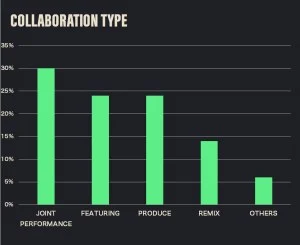
MUSIC AWARDS JAPAN’s Best Cross-Border Collaboration Entries Give Insight on How Japanese Music Connects With the World
Written by djfrosty on April 17, 2025
The inaugural MUSIC AWARDS JAPAN ceremony, the largest music awards in the country, is set to take place in May in Kyoto. Embodying the theme of “Connecting the world, illuminating the future of music,” the new international music awards is hosted by the Japan Culture and Entertainment Industry Promotion Association (CEIPA), an association jointly established by five major organizations in the Japanese music industry.
This year’s MAJ will recognize works and artists in more than 60 categories, including the six major awards for Song of the Year, Artist of the Year and more, which have gained significant attention and recognition from Jan. 29, 2024 to Jan. 26, 2025. The entries for each category were announced last month and the nominees for each category was revealed Thursday (Apr. 17).
Trending on Billboard
The third installment of Billboard Japan’s series exploring the trends and characteristics of MAJ will focus on the entries in the Best Cross-Border Collaboration Song category that honors songs written in collaboration between domestic and overseas artists. Let’s take a look at how Japanese music interacts with the world, using data of the entries for this award.
The Artists’ Involvement in the Creative Process is Key
We divided the 50 entries into five types and calculated the percentage of songs in each. “JOINT PERFORMANCE” refers to co-writing as well as joint performances, and “FEATURING” refers to guest appearances (remixes of existing songs fall under “REMIX”). More than half the entries fall under JOINT PERFORMANCE or FEATURING.
“PRODUCE” refers to tracks where artists from overseas participate as producers in songs by Japanese artists, and accounts for 24% of the total. This includes Fujii Kaze’s “Feelin’ Go(o)d”, f5ve’s “UFO” (both produced by A.G. Cook), and ONE OR EIGHT’s “Don’t Tell Nobody” (produced by Ryan Tedder of One Republic).
For many of the songs that fall under JOINT PERFORMANCE, FEATURING and PRODUCE, the artists themselves participated in the creative process, such as writing the lyrics and composing the music. In the second installment of this series, we noted that the entries in the Top Global Hits from Japan category seem to be slightly more oriented towards artists who write and perform their own works compared to those up for the Song of the Year award, which honors songs popular in Japan. The same can be said for collaborative works that span countries and regions. It seems that, compared to within Japan, it’s more important for artists to be actively involved in the creative process overseas, both from the perspective of listeners and creators.
Affinity With the Collaborators’ Nationalities
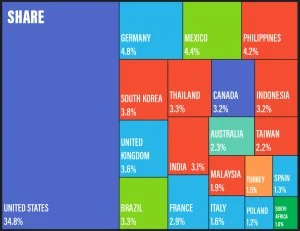
The above shows the share of each country/region excluding Japan, calculated by adding up the number of streams of all entries in the Best Cross-Border Collaboration Song category during the tallying period. The country with the highest share was the United States, and it also leads the list of the collaborators’ nationalities, which we’ll touch on later, but the order below second place didn’t match the collaborators’ nationalities at all. This shows that the collaborators’ nationalities and the countries/regions where the songs are actually listened to do not necessarily match.
For example, “Bekhauf,” the collab between BABYMETAL and the Indian metal band Bloodywood, accounted for 1% of the streaming numbers in India. Meanwhile, “RATATATA,” the collab between BABYMETAL and the German metal band Electric Callboy, accounted for 49% of the streaming numbers in Germany. One reason for this difference is that the market for metal music in Germany is more mature than in India. From this trend, we can see that affinity with the collaborators’ nationality is also an important factor in maximizing the effect of collaborations.
Countries/regions Interested in Collabs Between Japanese and Foreign Acts
Megan Thee Stallion’s “Mamushi (feat. Yuki Chiba)” was the collaborative number with the most streams among this year’s entries, with an large share in multiple countries/regions including the U.S. (68%), the Philippines (79%), India and South Africa (both 87%). When there’s a song with such an overwhelming share, the overall share is greatly influenced by the trend of that song.
So to identify countries/regions with high interest in collaborative songs in general, rather than a specific one, we extracted the top 10 countries/regions for each song’s streaming numbers and compiled the number of songs that charted in the top 10 by country/region. Countries/regions ranked multiple times in the top 10 of each song’s list likely have strong tendencies to consistently support collabs between Japanese and overseas artists.
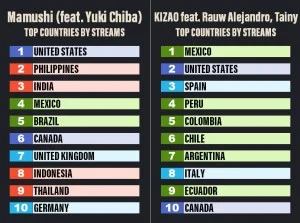
Top Countries Excl. Japan by Streams According to Luminate
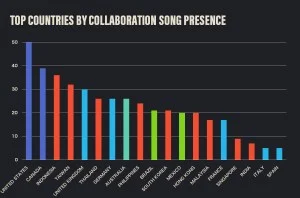
Total Number of Entry Songs in Top 10 by Country/Region
Canada, Indonesia, and Taiwan came in at Nos. 2, 3, and 4. These are all countries/regions that didn’t rank high in terms of collaborators’ nationalities and streaming numbers. These countries/regions are considered to have high interest in songs featuring Japanese artists, regardless of who they collaborate with. Taiwan, in particular, had 32 songs in the top 10 despite its relatively small population.
The Properties of Collaborative Songs
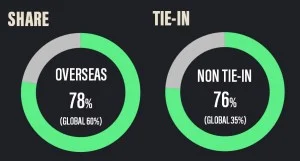
Next, looking at the domestic and international streaming shares of the entries in the Best Cross-Border Collaboration Song category during the tallying period, 78% of the total streaming count for all 50 songs combined came from outside Japan. This is higher than the percentage of overseas streams for the entries in the Top Global Hits from Japan category, an award for Japanese music being listened to outside the country (59%), indicating that collaborative songs are more actively listened to overseas. Approximately 80% of the songs weren’t linked to other works or products, suggesting that whether or not a collaborative song is a tie-in doesn’t influence its popularity.
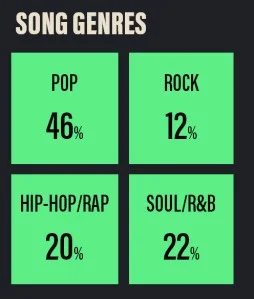
The chart above shows the genre breakdown of the entries. Soul/R&B accounts for 22% of the total, largely due to the six songs by SIRUP that made the list. Hip-Hop/Rap accounts for 20%, and here, all tracks except for two by Chanmina are by different artists. Notably, the share in this genre is 15% more than the 5% in Top Global Hits from Japan.
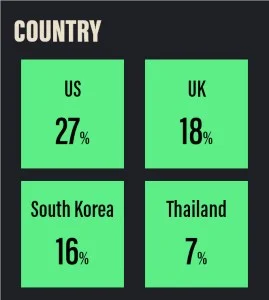
The percentage of the collaborators’ nationalities was calculated based on the number of artists. The United States (27%) had the highest percentage, with many collaborations with rappers such as Megan Thee Stallion and Big Sean. The United Kingdom (18%) featured artists associated with Hikaru Utada, such as Sam Smith and A.G. Cook.
South Korea has entries featuring rappers such as ASH ISLAND and Zion.T, as well as collaborative tracks with dance and vocal groups like ATEEZ. Three songs have entered from Thailand: BALLISTIK BOYZ from EXILE TRIBE’s “Meant to be feat. F.HERO & BOOM BOOM CASH,” ATARASHII GAKKO!’s “Drama (feat. MILLI),” and HYBS x SIRUP’s “I’m Blessed.”
Cross-border collaborations are becoming an important channel connecting Japanese music with the world, and the Best Cross-Border Collaboration Song award is a symbolic category that captures this global trend. We hope this award will serve as an opportunity to further enhance the presence of Japanese artists in the international music scene.

 State Champ Radio
State Champ Radio 





